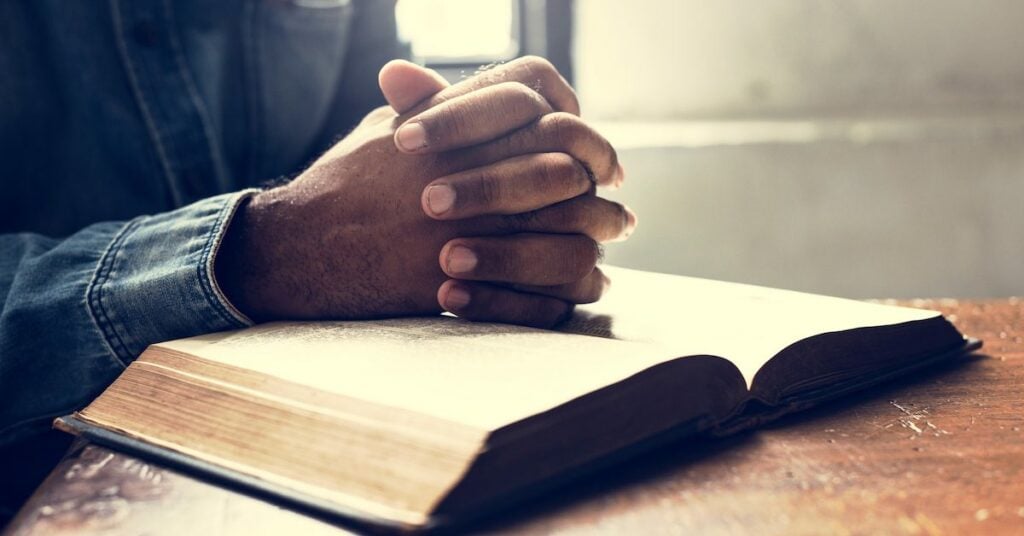When your religion rejects you, what comes next?
Reviewed by Susan Radzilowski, MSW, LMSW, ACSW


When Matt Marr’s father died a few years ago, he was crushed. But he’d also been preparing for the loss for decades.


As a young gay man, Marr says, he had already mourned his dad proactively. Like many LGBTQIA+ youth, he felt he needed to brace himself for the very real possibility that his family, his community, and his church might reject him.
“Before I came out to my family, I had to imagine what my life would look like if I didn’t have a community who accepted me,” Marr says. “What if my parents decided they didn’t want me anymore?”
Growing up in a small, conservative Southern town, Marr feared he would never be accepted as a gay person. After coming out at 19, he knew he couldn’t stay. He left home, earned a master’s degree in clinical psychology, and eventually settled in California.
Marr’s story has a happy ending: His parents embraced him and his identity. But he knows he’s one of the lucky ones, and many people face the same rejection he once feared. That’s why he has dedicated much of his life to advocating for LGBTQIA+ youth who’ve experienced religious trauma.
What is religious trauma?
Religious trauma can happen when a person’s religious experience is stressful, degrading, dangerous, abusive, or damaging.
If your religion or religious community causes you to feel bad about your identity or choices you’ve made for yourself, you may be experiencing religious trauma. Other signs include struggling to make decisions without guidance from your religious institution or feeling shame about decisions you do make. You may find it difficult to set boundaries and have them respected, and you may tend toward perfectionism.
This type of trauma can lead to or worsen existing mental health conditions such as posttraumatic stress disorder (PTSD), depression, and anxiety. Sometimes people don’t realize they’ve suffered religious trauma until after they’ve left the faith or cut ties with their religious community.
Outcomes of religious trauma
Therapist Margaret Conley, LCSW, MDiv, specializes in treating religious trauma in the LGBTQIA+ community. She says there are two core ways religion can harm people whose identities may not align with the traditions of their faith.
The misuse of sacred texts: Conley cites the misunderstanding of Romans 1:26 as an example. “People have taken this Bible passage to mean you cannot be gay. Because of that, they have punished individuals and demonized them,” she says. “Clinically, we call that the ‘unattached burden.’ Then the church tries to remove that burden by getting it out of you, praying it out of you, fasting it out of you.” Conley says this often leads to excommunication from the church or community.
The role of suppression: The rules of religion may cause people to suppress their true selves, says Conley, “which leads to oppression, which means now you now have this culture of being down-low or hidden within spiritual spaces.” If someone feels they must hide their identity or forgo it entirely, “this brings internal harm, because I can’t rectify these parts that you’re asking me to suppress,” she explains. Suppression is also at the root of conversion therapy, a set of harmful practices that try to alter someone’s sexual orientation or gender identity.
Perhaps the most damaging outcome of religious trauma is loss of community. Millions of people are raised in communities tied together by belief. Breaking ties with an unhealthy religious community—and leaving behind your support system—can be an incredibly difficult step.
The fallout from family rejection
For some LGBTQIA+ people, family rejection is an especially pressing concern.1
In one study, LGBTQIA+ teens in the United States were three times more likely than heterosexual teens to live in foster care and three times more likely to have considered suicide as a result of family rejection.2 A separate study of White and Latino gay, lesbian, and bisexual young adults showed they were more than eight times likelier to report having attempted suicide and almost six times likelier to report high levels of depression.3
Conley says the idea of rejection by loved ones can be particularly difficult for transgender people because they may experience it twice if they opt to have gender-affirming surgery: “Once when they decide to walk in their truth and understand themselves, then again when they’re able to surgically become themselves.”
Family acceptance and affirmation, on the other hand, act as protective factors against depression, suicidality, and substance misuse.4 These positive practices can be learned through counseling, coaching, and psychoeducation.5 If you’re not sure where to start, the nonprofit organization PFLAG offers support groups, literature, and other resources for families.
A new path to community
Some of Marr’s fondest childhood memories revolve around his church: His faith was a core part of his identity and shaped his understanding of the world. When he realized he was gay, that worldview changed. At first he felt forced to choose between being himself and being the person his faith accepted, but he came to believe he could reconcile the two.
Though his relationship with his childhood community ended, Marr says, he still felt connected to his beliefs. He found new spiritual communities that affirmed his sexuality, so he didn’t have to suppress a part of himself in order to belong.
If you’ve separated from your family or religious community because they don’t affirm your identity, you can build a new support system—and even, as Marr did, stay connected to your religious faith if you want to. Here are three ways to get started.
Reframe your faith. From a young age, Marr started reading about spirituality and following some of the biggest names in self-help, like frequent “Oprah” guest Gary Zukav. This practice, in combination with therapy, helped him come to a new understanding. “One day I realized, ‘God made you this way, and God doesn’t make mistakes,’” Marr says. Shedding the ideas of sin and shame and focusing on the core tenets of his faith helped him get through hard times in his adolescence.
Build a “found” or “chosen” family. This refers to the friends and loved ones you choose to keep in your life. If you feel rejected by your family of origin or religious community, you can go on to find other communities where you feel loved and accepted.6 Your chosen family might include coworkers, classmates, or neighbors. Online communities can also help you connect positively with peers, especially when you’re young.7
Find inclusive spaces that cultivate belonging. Marr spent years working with young people as one of the founding directors of Brave Trails, California’s first leadership camp for LGBTQIA+ youth.8 Through the camp, Marr met dozens of kids who felt rejected by communities they once loved and helped them work through the resulting trauma to rebuild or reclaim their identities. Today he cohosts the podcast Reality Gays, which has an online community of more than 10,000 fans cheering each other on.
How to find support
A mental health professional can help you process religious trauma using a range of methods, including:
- Cognitive behavioral therapy (CBT)
- Cognitive processing therapy (CPT)
- Eye movement desensitization and reprocessing (EMDR)
- Prolonged exposure therapy
- Radically open dialectical behavior therapy (RO-DBT)
- Somatic therapy
- Faith-based therapy
In addition to brainspotting, a newer approach to treating PTSD, Conley has found success with relational models like Internal Family Systems (IFS), where clients are asked to work with the perceived parts of themselves to reach a better understanding of their whole selves.9
“Sometimes a client has a part that is protecting themselves in spaces where they’re not open yet,” says Conley. “I ask them, does this part know that you’re 32 and you’ve come out and you’re married to your partner? Because this part is still presenting as if you’re a heterosexual female at every Christmas party and leaving your partner in the car because you don’t want to interrupt your mom’s life.”
Grief therapy is also helpful for Conley’s clients who “must grieve the loss of their biological family as a primary source of care,” she says, “but also must grieve the fact that they didn’t know what a healthy primary source of care was.”
Ways to offer support
As a friend or family member of an LGBTQIA+ person who has experienced religious trauma and feels rejected by their faith community, you may be searching for ways to help your loved one. You may also be struggling with how to reconcile your religious beliefs with the love and acceptance you feel for this person. Here are some ways you can help.
Reconsider your spiritual texts. Conley says it’s long past time for faith leaders and followers to look closely at the texts they hold sacred—and to give themselves permission to explore alternate points of view. “I’m going to have to intersect my spirituality, my understanding of religion, my faith community, and what the sacred texts really look like,” Conley explains. “The sacred text isn’t just the Bible. The sacred texts may include hymns or the stories passed down from generation to generation.”
Redefine inclusion. Conley uses the metaphor of a home that needs major work. “We are asking our spiritual spaces to check their foundation,” she says. “We need to tear down your house. And when we rebuild it, we need to make sure that we lay a foundation that is inclusive.” It’s not enough to be accepting, Conley explains. Affirming and including go much further in helping someone feel wanted, protected, and loved.
Reorganize your house. Marr says there are ways for parents to belong to a religious institution and support their LGBTQIA+ child. “One of the most important things parents can do is to put themselves aside and ask if they are really focused on the needs of their child,” he says. To do this, he suggests a simple shift in perspective: “Just put your faith in another room. It’s still in your house,” says Marr. “What if you put it in another room for now? What will happen is you will hopefully start to turn your attention to your child.”
“Sugar, you have me”
For many people, religion connects us and helps us feel like part of a larger community. So when that connection is cut, it can be devastating—especially if you’re trying to figure out who you are, or if you’ve suppressed your true self for much of your life.
At the end of the day, we all want to know we’re not alone. If you’re struggling, help is available now. The Trevor Project offers 24/7 support for LGBTQIA+ youth, and the It Gets Better Project has created an online community for young people to share stories and build social connection. For people of all ages, the LGBT National Hotline is available Monday through Friday, 1 p.m. to 9 p.m. PT, and Saturday, 9 a.m. to 2 p.m. PT.
When he worked for the Trevor Project’s crisis hotline, Marr remembers, young people would call and say they had no one. “I would say, ‘Sugar, you have me,’ and that would make such a difference. You could actually hear the relief in their voice.”

Sources
1 https://onlinelibrary.wiley.com/doi/full/10.1111/j.1744-6171.2010.00246.x/
2 https://doi.org/10.1542/peds.2017-4211/
3 https://pubmed.ncbi.nlm.nih.gov/19117902/
4 https://onlinelibrary.wiley.com/doi/full/10.1111/j.1744-6171.2010.00246.x#b15/
5 https://link.springer.com/article/10.1007/s40596-017-0728-y/
6 https://www.nytimes.com/2022/06/25/well/lgbtq-chosen-families.html/
7 https://www.glsen.org/news/out-online-experiences-lgbt-youth-internet/
8 https://people.com/celebrity/camp-brave-trails-inside-californias-first-leadership-camp-for-lgbtq-youths/
9 https://cab.unime.it/journals/index.php/MJCP/article/view/1376/
About the author
Amye Archer, MFA, is the author of “Fat Girl, Skinny” and the coeditor of “If I Don’t Make It, I Love You: Survivors in the Aftermath of School Shootings,” and her work has appeared in Creative Nonfiction magazine, Longreads, Brevity, and more. Her podcast, “Gen X, This Is Why,” reexamines media from the ’70s and ’80s. She holds a Master of Fine Arts in creative nonfiction and lives with her husband, twin daughters, and various pets in Pennsylvania.
Related articles

The relationship between faith and therapy
Mental health professionals and faith leaders offer different kinds of guidance...

Religious trauma: Signs, symptoms, causes, and treatment
Learn about religious trauma and spiritual abuse, how they affect mental...

Religion, spirituality, and mental health
Learn the positive and negative mental health benefits of both religion and...

Total liberation: A Buddhist approach to healing
Harm reduction. Symptom management. Lowering “subjective units of...
